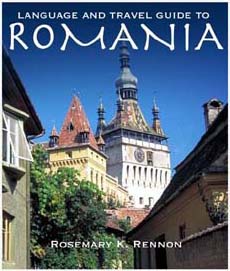 A World of Adventure
A World of Adventure
 A World of Adventure
A World of Adventure
|
| BUCHAREST | WALLACHIA | TRANSYLVANIA | MOLDAVIA | MARAMURES | CRISANA & BANAT | THE BLACK SEA | DANUBE DELTA |
at Amazon.com  For details and addresses for Wallachia's attractions, history, architecture, monasteries, spas, etc. get the new Language and Travel Guide to Romania published by Hippocrene Books.
|
WALLACHIAThe medieval territory south of the Carpathian mountains and north of the Danube river was the first independent principality of the Romanians. Wallachia (land of the Vlachs or Wallachs) was founded in 1290 by Radu Negru as a feudal state with allegiance to Hungary. But in 1310, Romanian Duke Basarab I took advantage of the ending of Hungary’s Arpad dynasty and refused to continue paying vassalage tributes to the kingdom. After a battle in 1330 to reclaim the territory, Hungary’s King Charles I was defeated by Basarab’s forces. Basarab was named Prince (Voivode) Basarab I, and the state became the independent principality of Wallachia. MapThe Wallachian Countryside
Muntenia Mogosoaia, just 14 km (9 miles) northwest of Bucharest’s center, is home to Mogosoaia Palace, built in 1672 by Prince Constantin Brancoveanu for his son on the shores of a lake; he also built a small church in honor of St. George. The brick and stone palace combines Byzantine decorative features with elements of both the Italian Renaissance and the Baroque. It is now the Museum of Brancovan Art with collections of silverware, wood sculptures, fabrics, including gold and silver thread embroideries, parchments, rare printed works and miniatures.
Prahova Valley
Sinaia, "Pearl of the Carpathians", so called for its beautiful mountain scenery, is a popular ski resort and home of magnificent Peles Castle, residence of King Carol I and Queen Elisabeta.
Azuga, a relatively new ski resort, also sits at the foot of Bucegi mountains and shares some facilites with Busteni. Azuga has the longest ski run in Romania, accesible by chair-lift. Predeal, the most popular ski resort in the country, marks the beginning of Transylvania. The highest town in Romania at 1,100 meters, it has 15 ski runs and trails for cross-country skiers and hikers. Snowboarders are welcome here.
Targoviste, on the bank of the Ialomita river, below the southern Carpathians, was the capital of feudal Wallachia from the 14th to the 17th century. A modern city now, it was the site of the trial and execution of Nicolae Ceausescu and his wife Elena in December 1989 that ended the Communist era in Romania.
Remnants of its past glory permeate the town:
Oltenia Râmnicu Vâlcea on the Olt river at the foothills of the Carpathians is an example of an older settlement that was “systematized” by the communist regime prior to 1989. Nevertheless, it has some lovely historic churches, 15th century Biserica Cetatuia being the oldest. Biserica Paraschiva is a good example of 16th century architecture. There is also the 19th century Episcopal Cathedral, built atop its original 16th century ruins. A memorial house dedicated to the writer Anton Pan is at Strada Stirbei Voda 18. Cozia Monastery on the Olt river was founded by Wallachia ruler Mircea cel Batran (Mircea the Wise) in 1388; in Byzantine style with interior frescoes from 1707. Bolnita, the infirmary church across the road, was built in 1542 with vivid interior frescoes. The Olt Pass is a twisting gorge cutting north through the Carpathians enroute to Sibiu. Govora Monasteries, little, white churches on oak-forested hills, built in 1491 and cared for by monks, are notaable for their flower gardens. Horezu has the largest and most beautiful medieval monastery, built by King Constantin Brancoveanu in 1694, with exterior columns carved with stone leaves and flowers. Its art collection includes icons, a photography museum, Brancovan silver and a library. Horezu is also reknown for its pottery. Târgu Jiu , on the Jiu River at the foot of the southern Carpathians, is home to native sculptor Constantin Brancusi's famous memorial complex in Târgu Jiu’s city park that commemorates Romanian soldiers who died here during World War I. Tismana's monastery, in the foothills of the mountains, is a 14th century Romanesque-style complex of white buildings with red roofs. Tismana holds an annual pottery fair in March and a dance festival every August. Craiova is a modern industrial center that began as the Roman fortress Pelendava in the time of Emperor Traianus. The 15th–18th centuries were its high point and Mihai Viteazul (Michael the Brave), the medieval leader who united the three Romanian kingdoms for the first time in 1600, ruled from there. Its oldest architectural monument is St. Dumitru Church, built in 1652. It also has a University, a National Theatre, an Opera, a Children’s Theatre, the Oltenia Philharmonic, an Art Museum and a regional Museum of Oltenia. Baile Herculane is the oldest spa in Romania, dating back to Roman times in the first century AD. It spans the Cerna river in a lush mountain valley at 152 m (500 ft.) altitude, not far from the Danube river. An 1847 statue of Hercules from King Carol I honors the legend that Hercules came here to heal his battle wounds in its mineral springs. In the 19th century it was popular with Emperor Franz Joseph and Empress Elisabeth of the Austro-Hungarian empire.
Drobeta-Turnu Severin, an ancient Dacian settlement, was made a castrum (fortified place) by conquering Romans (per 2nd century Greek geographer Ptolemy of Alexandria); it rose to rank of municipium by emperor Hadrian in 124, and emperor Septimius Severus (AD 193-211) named it a colonia. Several monuments, including ruins of a Roman fortress and its baths, have being uncovered by archeologists. Its most impressive features are vestiges of the bridge built across the Danube by architect Apollodorus of Damascus for Emperor Traianus to move his army across the Danube to conquer Dacia.
The Danube River
|
 www.CulturalRomtour.com
|